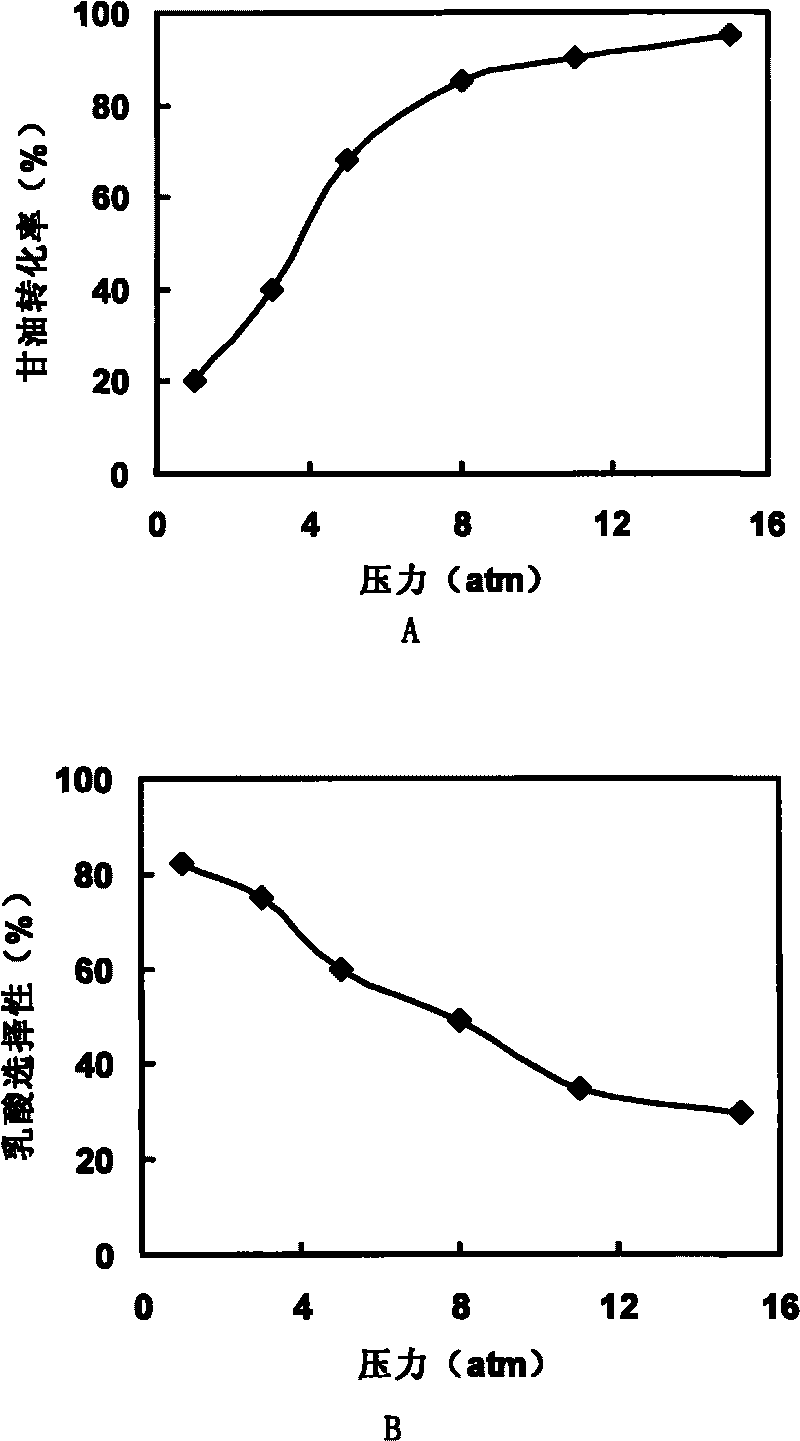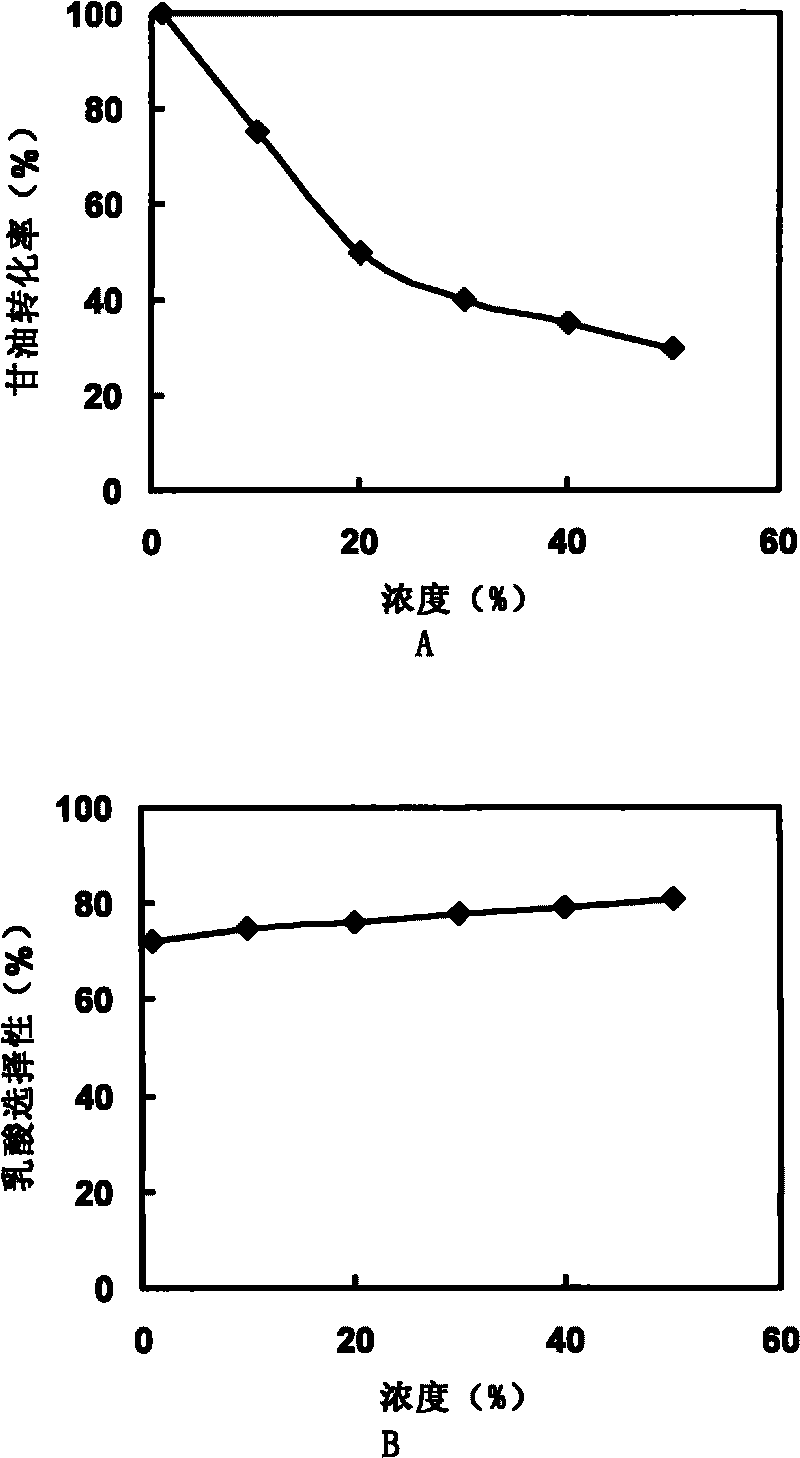Method for producing lactic acid by using glycerin and special catalyst for production of lactic acid by using glycerin
A catalyst, lactic acid technology, applied in the direction of catalyst activation/preparation, physical/chemical process catalyst, metal/metal oxide/metal hydroxide catalyst, etc., can solve the problem of high equipment requirements, increased equipment investment costs, high water heat stress and other issues
- Summary
- Abstract
- Description
- Claims
- Application Information
AI Technical Summary
Problems solved by technology
Method used
Image
Examples
Embodiment 1
[0062] Embodiment 1, impregnation method prepares ZrO 2 Supported Pt-Pd Bimetallic Catalysts
[0063] Solution A (15mL): the solute is H 2 PtCl 6 ·6H 2 O, the solvent is water; the mass percentage composition of Pt is 0.5% in the solution A; contains 0.075g Pt in the solution A;
[0064] Solution B (15mL): the solute is PdCl 2 , the solvent is HCl aqueous solution (the mass percentage of HCl is 10%); the mass percentage of Pd in the solution B is 0.75%; the solution B contains 0.1125g of Pd.
[0065] Mix solution A with solution B, add 5g ZrO 2 Carrier (Xilong Chemical Factory, Shantou City; batch number 060414); stirred at 30°C for 2h, dried, and then reduced at 200°C for 3h under a hydrogen atmosphere to obtain 2 Pt-Pd bimetallic supported catalysts (Pt-Pd / ZrO 2 ).
[0066] Characterized by plasma emission spectrometry (ICP), it was analyzed that the mass percentage of Pt loaded on the surface was 1.485%, and the mass percentage of Pd loaded on the surface was 2.24...
Embodiment 2
[0067] Embodiment 2, impregnation method prepares the Pt-Pd bimetallic catalyst supported by activated carbon
[0068] Solution A (20mL): the solute is H 2 PtCl 6 ·6H 2 O, solvent is water; The mass percentage composition of Pt is 0.5% in the solution A; Contain 0.1g Pt in the solution A;
[0069] Solution B (20mL): the solute is PdCl 2 , the solvent is HCl aqueous solution (the mass percentage of HCl is 10%); the mass percentage of Pd in the solution B is 0.75%; the solution B contains 0.15g Pd.
[0070] Solution A was mixed with solution B, and 3 g of activated carbon carrier (Shanghai Activated Carbon Factory Co., Ltd.; batch number 0255436) was added thereto; stirred at 30° C. for 2 h, dried, and then reduced at 200° C. for 3 h under a hydrogen atmosphere. A Pt-Pd bimetallic supported catalyst (Pt-Pd / activated carbon) supported on activated carbon was obtained.
[0071] Characterized by plasma emission spectrometry (ICP), it was analyzed that the mass percentage of ...
Embodiment 3
[0072] Embodiment 3, coprecipitation method prepares Fe 2 o 3 Supported Pt-Rh Bimetallic Catalysts
[0073] Solution A: 20g Fe(NO 3 ) 3 9H 2 O dissolved in 150mL water, and 10mL H 2 PtCl 6 ·6H 2 O aqueous solution (the mass percent content of Pt is 0.5%) and 15mL RhCl 3 ·3H 2 O aqueous solution (mass percentage composition of Rh is 1%) is mixed, obtains solution A; In solution A, contains 0.05g Pt, 0.15g Rh;
[0074] Solution B: 40g NaOH was dissolved in 100mL water to obtain solution B.
[0075]At the same time, solution A and solution B were added dropwise into 200mL of water by means of co-current dropwise addition, during which the NaOH drop rate was adjusted to control the pH value to 9, then stirred at 50°C for 4h, suction filtered and washed until there was no Cl in the filtrate - Detected, dried and reduced at 350°C for 4h under a hydrogen atmosphere. get loaded on Fe 2 o 3 Pt-Rh bimetallic catalyst (Pt-Rh / Fe 2 o 3 ).
[0076] Characterized by plasma em...
PUM
 Login to View More
Login to View More Abstract
Description
Claims
Application Information
 Login to View More
Login to View More - R&D
- Intellectual Property
- Life Sciences
- Materials
- Tech Scout
- Unparalleled Data Quality
- Higher Quality Content
- 60% Fewer Hallucinations
Browse by: Latest US Patents, China's latest patents, Technical Efficacy Thesaurus, Application Domain, Technology Topic, Popular Technical Reports.
© 2025 PatSnap. All rights reserved.Legal|Privacy policy|Modern Slavery Act Transparency Statement|Sitemap|About US| Contact US: help@patsnap.com



